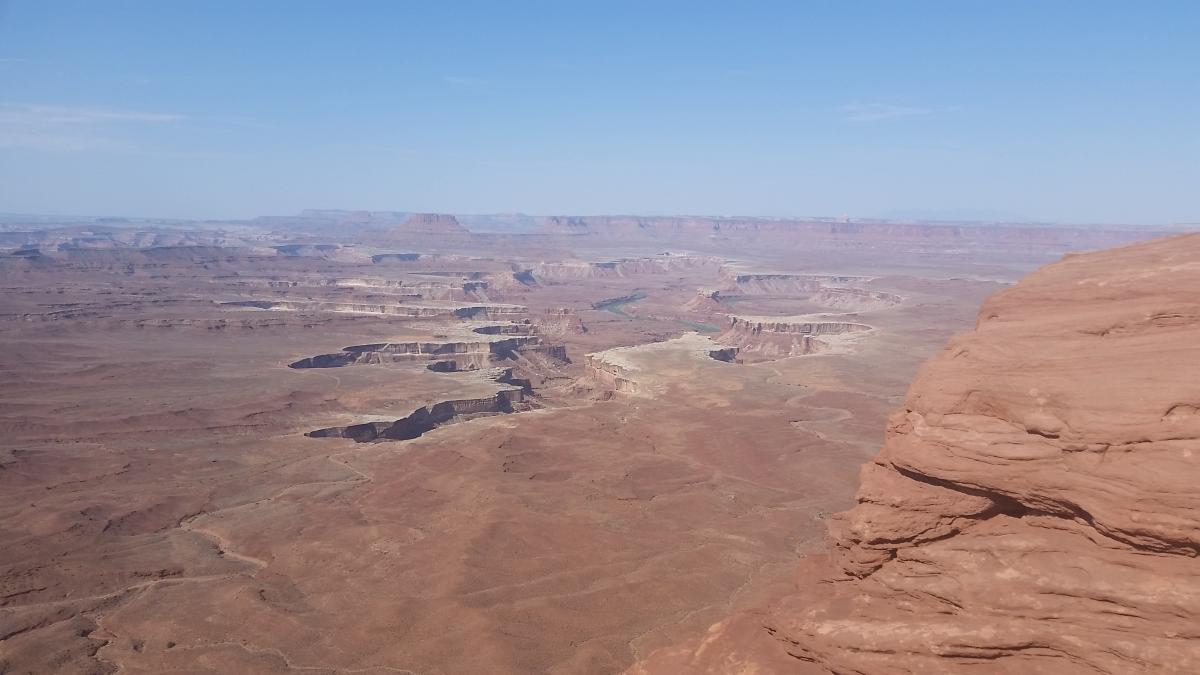There is a particular feeling that arises when you see something very grand and beautiful in the natural world. Or, at least, I thought there was a particular feeling, but in the past week I have had an opportunity to see many people have this kind of striking encounter, and I noticed some more variation than I expected.
For the past week, my family and I have been traveling across the country. In Utah, we visited both Arches and Canyonlands National Parks. These parks are not only rare and beautiful places, they are also valuable windows into geologic time. Which means, of course, that they are places where worldviews collide. Creationists do not see evidence of an ancient Earth. Instead they see evidence of Noah’s flood. As we have recently seen in the news, creationists have even been granted permission to collect samples from Grand Canyon National Park, although their purposes are something less than scientific, since falsifiability is not in the picture. As the collector in question states:
“Even if I don’t find the evidence I think I will find, it wouldn’t assault my core beliefs,” creationist Andrew Snelling told The Australian. “We already have evidence that is consistent with a great flood that swept the world.”
Arches and Canyonlands both invite the same questions as the Grand Canyon. As you can see in this photograph, taken from the Green River Overlook at Island in the Sky (such a  romantic name!) one is able to see fairly easily that this incredible landscape has been carved by the Colorado River, whose size and course appear to have changed considerably over time. It takes considerable hand-waving to ascribe this landscape to The Flood.
romantic name!) one is able to see fairly easily that this incredible landscape has been carved by the Colorado River, whose size and course appear to have changed considerably over time. It takes considerable hand-waving to ascribe this landscape to The Flood.
The Park Service provides straightforward, well-designed educational materials that teach about the landscapes and rock formations using a geologic timescale. With my background as a microbiologist, I was also pleased to see the big push they’re making to educate the public about cryptobiotic soil crusts, with highly visible exhibits and signs in every desert park we’ve visited. Will this information stop people from walking off desert trails? I hope so. Will straightforward, factual materials about geological processes end the creationist conflict? Track record’s not great so far. But I was proud to see that the Park Service did not do anything to engage in “debate” on the origins of geologic features.
When observing people interacting with these educational materials, there were a couple of things worth noting. The first was how many people were visiting the parks. We were visiting the parks in July, with daytime temperatures over a hundred degrees, which prominent signs informed us could cause us to die. Hundreds and hundreds of people were hiking around regardless, because, like us, they really wanted to be there. They wanted to engage with the natural world.
The second thing was the range of emotional reactions amongst the visitors. While the most prevalent reaction to the grandeur of our surroundings was something like awe, a joyful sense of something much larger than oneself, there was also a significant subset of people who appeared to feel something more akin to profound self-satisfaction (and then, of course, there were those who were just in it for the selfies). Although this is hardly a scientific study—I didn’t go up and ask people any questions—I wonder if there is some relevant kernel to be mined from this inward/outward emotional response to these grand landscapes. Could this be how some creationists feel when they see these things—not that they are part of a large and ancient world, but that this magnificent place was created for them? Some conversations I’ve had with creationists support this explanation and I suppose I can see the appeal of feeling so special and cared for. Such feelings are not superficial or shallow; they are part of a radically different way of relating to the world and to God that is present in the creationist community.
It should be noted this is not necessarily how most mainstream religious people parse the Grand Canyon. Many—perhaps even most—people who believe in God do not find evidence of unimaginably ancient and powerful natural processes to be inconsistent with their faith. The profound emotional sense that the world was created for oneself, that the world and its splendor is explicitly and entirely for human ends, is a different response, and worth exploring.
And if that emotional response is part of why evidence won’t “assault the core beliefs” of people like Snelling, perhaps we should consider the validity of engaging in communication about our feelings along with evidence. While the straightforward, accurate, meaningful educational materials provided by the Park Service avoid many potential communication pitfalls and provide people with important information, they rarely consider how the evidence they present makes people feel.
I suspect that, for many of us, considering geologic time in these magnificent landscapes does not cause us to feel diminished or alone, but fortunate and exhilarated. Not only are we able to engage with and be part of something so immense, so totally beyond the scope and scale of our human lives, but, even better, even with the very little time we have on this planet, we can understand the forces that shaped these places.
These are wonderful feelings. If arguments from reason are being met with arguments of belief, as in the Grand Canyon case above, perhaps we should prepare to respond with more than reason alone.

